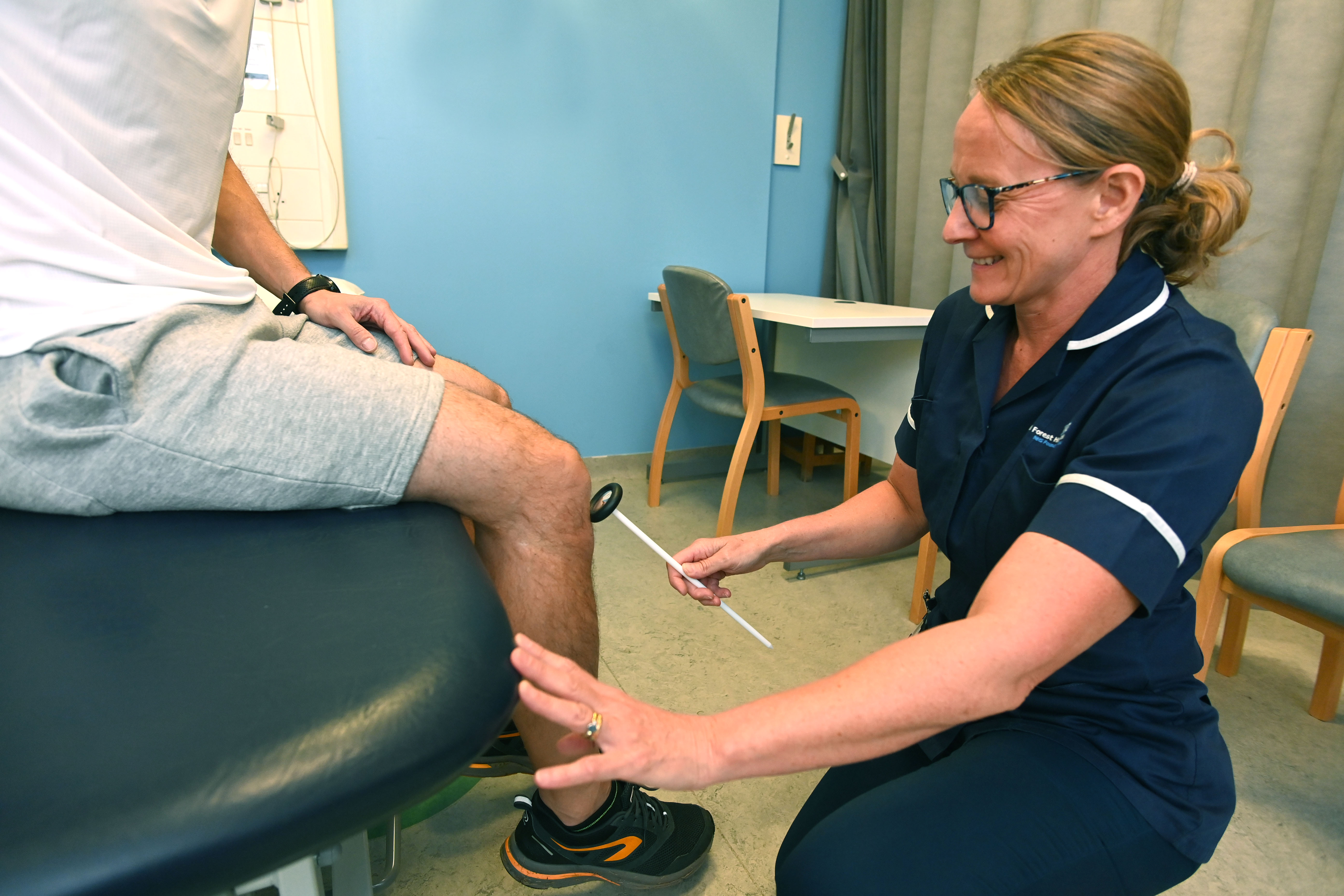Osteoarthritis care plan
Osteoarthritis (OA) is the most common type of arthritis, affecting over nine million people in the UK.
It can affect the joints of the hip, shoulder foot or hand and is the leading cause of knee pain in people over 45.
The purpose of this guide is to help you understand and manage this condition so you can stay active, healthy and fit in order to continue doing the things you enjoy.
OA is usually diagnosed by a healthcare professional based on your symptoms.
It may be suspected if:
- You are 45 years or older.
- Your joint pain worsens with activity.
- Your stiffness is not present in the morning or lasts less than 30 minutes.
Further tests such as X-rays or blood tests are not usually needed, unless other conditions need to be ruled out.
In OA, the smooth joint covering (cartilage) becomes thinner and rougher, leading to pain, stiffness, and inflammation.
Symptoms may affect one or both sides of the body, and can include:
- Pain that worsens with movement and improves with rest
- Stiffness, especially after sitting still, which lasts less than 30 minutes in the morning
- Swelling around the joint
- A creaking or cracking sound in the knee
- Muscle weakness which makes the knee feel unstable
- Pain with specific tasks such as using stairs
- Flare-ups with good and bad days
- Changes in the knee shape over time.
It can be difficult to hear that you have osteoarthritis, but it's important to know that symptoms do not always worsen with time, and they often stay stable and can improve.
It may be more helpful to think of osteoarthritis as a condition with a "dimmer switch" with symptoms that can be turned up or down, or as a wear, tear and repair process which is often successful in allowing the knee joint to continue to function well.
A study of 8,000 people with early to moderate knee arthritis found that in 85% of people symptoms stayed in a steady state, with 8% actually experiencing an improvement.
OA most often affects people over 45. Risk factors include:
- age and genetics
- past injuries to the knee.
Although some of these issues are uncontrollable, there are many other lifestyle factors that can be improved in order to protect your knees, reduce symptoms, and slow the progression of osteoarthritis.
Helpful areas to focus on may be different for everyone but can include:
- Fitness and strength: Regular activity supports your joints
- Diet and weight: A healthy weight reduces stress on knees and inflammation in our bodies
- Education: Understanding OA empowers you to manage it
- Mental health: A positive mindset can reduce pain and help you feel better
- Sleep: Good sleep allows the body to rest and repair
- Smoking and alcohol: Reducing both improves inflammation, circulation, and overall health.
Exercise is one of the most effective treatments for OA. It strengthens muscles, reduces stiffness and improves function.
Aim for two and a half hours to three hours of moderate intensity, aerobic exercise per week (or an hour and 15 minutes of vigorous activity).
As well as this, perform strengthening exercises performed at least three times per week on non-consecutive days.
The video below outlines the World Health Organization (WHO) guidelines on physical activity:
Aerobic work
We should all be doing approximately two and a half hours to three hours of moderate intensity, aerobic exercise per week.
Activities like brisk walking, swimming, and cycling can assist with general health and weight loss. These activities release endorphins, which are the body's natural "feel good" chemicals and pain relievers.
It is important to find an aerobic exercise that you enjoy, as you will need to continue it in the long-term to get the best outcomes.
Examples of moderate-intensity exercises include:
- Brisk walking
- Water aerobics
- Riding a bike
- Dancing
- Doubles tennis
- Pushing a lawn mower
- Hiking
- Rollerblading.
You can also achieve your weekly activity target with an hour and 15 minutes a week of more vigorous activity, such as:
- Running
- Swimming
- Riding a bike fast or on hills
- Walking up stairs
- Sports, like football, rugby, netball, and hockey
- Skipping
- Aerobics
- Gymnastics
- Martial arts.
Strengthening exercises
Strengthening exercises are crucial for building the muscles that support our joints.
To feel the health benefits from strength exercises, you should do them to the point where you need a short rest before repeating the activity, and they should be performed on three non-consecutive days a week.
There are many ways you can strengthen your muscles, whether you're at home or in a gym.
Examples of muscle-strengthening activities include:
- Carrying heavy shopping bags
- Yoga, Pilates, and tai chi
- Lifting weights or working with resistance bands
- Bodyweight exercises, such as push-ups, squats and lunges
- Heavy gardening, such as digging and shovelling
- Wheeling a wheelchair
- Lifting and carrying children.

Let's move with Leon is a 12 week programme of 30 minute movement sessions presented by fitness expert Leon Wormley.
Let's move with Leon offers a holistic, full-body programme that will improve strength, flexibility and cardiovascular fitness. You don’t need any special gear, and there’s no cost. Leon specialises in working with people with arthritis and related conditions and has a fun, motivational and inclusive approach.
The programme has been created for people with Musculoskeletal (MSK) conditions who want more movement in their lives. Created by Versus Arthritis and funded by Sport England you can access the program by visiting the Arthritis UK website.
Thumb arthritis
If you are suffering with arthritis which affects your thumbs, Keele University has an excellent management program. Please remember, consistency is key, and it may take several months to see results.
Other resources
If you are currently doing less than 60 minutes of exercise a week the your Health Notts team offers tree tailored exercise programmes to help start you on your fitness journey. Visit the Your Health Notts website for more information.
You can also enrol in specialist health sessions which include Otago balance and strength groups, cardiac rehab, and stroke ability classes.
Or if you are interested in improving your health and joining a gym speak to your health professional about discounted gym referral schemes, including Everyone Active and Active for today in the Newark region and the Healthy Life Initiative in Mansfield.
These programs offer a 12-week discounted membership to your local gym and access to an instructor who can work with you to develop a fitness program, which can incorporate activities such as:
- Sports or groups
- Chair based exercise
- Swimming
- Group exercise classes
- Water based activities like Aqua Fit
- Gym-based exercise.
The NHS Fitness Studio has an online library of exercise videos covering aerobic and strength training, including activities like Pilates and Yoga.
View NHS Fitness Studio exercise videos.
If you’re looking for local groups and classes, Notts Help Yourself has a searchable list of local activities.
Visit the Notts Help Yourself website.
The NHS Better Health website also has some advice and tools to help you get more active.
Finally If you enjoy walking, you might be interested in joining a walking group through Walk Notts.
Losing even a small amount of weight can reduce pressure on your joints and lower inflammation in the body.
Benefits include less pain, better mobility, and lower risk of surgery.
You can make simple changes, such as replacing sugary breakfast cereals with eggs, which have a higher protein content and may keep you feeling full for longer.
Try to reduce your intake of ultra-processed foods and replace them with things you could find in nature, such as nuts and fruit.
Some tips for managing weight:
- Aim to lose 1 to 2lb a week (0.5 to 1kg) for steady, sustainable weight loss.
- Replace processed foods with whole foods like fruit, nuts, and vegetables
- Stay hydrated and swap sugary drinks for plenty of water
- Base meals on whole grains and add protein such as eggs, beans, fish, or lean meat
- Eat at least five portions of fruit and vegetables daily
- Get active for two hours and thirty minutes a week
- Don’t stock unhealthy food
- Do not try to lose weight suddenly with fad diets.
Losing 5-10% of your body weight can lead to a substantial reduction in symptoms and lower the risk of things like joint replacement surgery.
Weight loss resources
You can self-refer to a free local weight loss service at Your Health Notts.
They can advise you on the steps needed to achieve a healthier weight, help you to set achievable and sustainable goals, and offer a flexible mix of face-to-face, online, or phone support.
The NHS websites below also have resources and tools, including weight loss plans, to help support you:
Heat or cold therapy
Cold
Applying ice or a pack of frozen vegetables to the knee joint can reduce swelling and help with pain. Do not apply ice directly to the skin but wrap it in a damp towel, and avoid applying for more than 15 minutes at a time.
Heat
Using heat on the muscles around your knee joint can help to ease pain and increase blood flow to the area. A hot water bottle or heat pack may be useful, but be careful to avoid skin burns.
Heat and ice can both have similar benefits, however, in general, cold should be used for a sudden flare-up of pain and swelling and heat for ongoing stiffness and aching.
Painkillers
Over the counter or prescription pain relief can play a role in managing symptoms of osteoarthritis, allowing you to continue to function and carry out your daily activities more comfortably.
Your GP may recommend taking pain relief as a short course rather than when the pain is bad.
To find out which painkillers are best for you, speak to your GP or pharmacist.
Steroid injections
Steroid injections can sometimes be administered by your health care professional as part of an active rehabilitation plan.
They can provide effective relief for joint pain and inflammation, although the improvement is usually temporary.
Research shows us that following a steroid injection people experience an average of two to 12 weeks of pain relief and sometimes see benefits for several months, although outcomes are never guaranteed.
If you are suffering with other types of pain including long term pain, fibromyalgia, chronic fatigue syndrome or long coronavirus, the Primary Integrated Community Pain Service (PICS) team have more help and information available.
Living with OA can affect your mood, sometimes causing anxiety or depression.
This can cause you to lose interest in the things you usually enjoy and when this happens, your pain can often feel worse too.
Physical and mental health go hand in hand. By staying positive and having strategies in place to keep moving forward, you can improve both your pain and function.
If you are struggling with your mood, Nottinghamshire Talking Therapies is a free and confidential NHS service that can help. If you're 18 or older and have a GP, you can sign up for free by visiting the Nottinghamshire Talking Therapies website.
Visit the NHS Every Mind Matters website to get helpful advice on how to look after your mental health every day.
Further links and services are also available through the NHS Mental Health website.
The Bee Free website offers ideas to improve both your mind and body.
Finally, Headspace offers great practical resources for mediation, mindfulness, mental health coaching and sleep.
Evidence shows how a good night's sleep can reduce pain levels and allow our body time to heal and recover.
Good sleep also benefits many other aspects of your health including your mood, productivity, and concentration.
For most people, it is beneficial to get between six and nine hours of consistent sleep.
Tips for a good night's sleep
- Set a consistent sleep schedule. Going to sleep and waking up at a similar time each day, even on weekends, will help regulate your body clock.
- Take time to relax and avoid looking at your phone or computer before bed. Try listening to music or reading a book rather than watching television.
- Stay away from caffeinated or sugary drinks in the hours before bed.
- Avoid long naps during the day.
- Manage your light exposure. Brighten your day by allowing natural sunlight in the morning and darken your nights with blackout blinds, dimming the lights in the evening and avoiding "blue screens".
- Avoid large meals before bed as this can disrupt your sleep.
- Regular exercise helps with sleep, but avoid anything too active an hour or two before bed.
- Keep your room cool and well-ventilated, as this is generally better than a hot and stuffy one.
You can find more sleep resources on the NHS Better Health website.
Supportive aids
Using a walking aid such as a walking pole can help keep you active and take some pressure away from the joints in your legs.
Footwear
Some people may benefit from making changes to their footwear by switching to more supportive shoes or using insoles to support the arch of their foot.
Unloading Knee braces
These specialist knee braces can be a useful, non-invasive option for some people. You may need to speak to your health professional for more information.
Flare-ups are temporary increases in pain that usually settle in a few days.
Create an action plan for when symptoms are worse before slowly building up your activity levels over a week or two.
An action plan could include the following:
- Rest and reduction of activity during pain peaks
- Adapting exercises to lighter versions (such as, stretches)
- Using pain relief as directed by a healthcare provider
- Trial of heat or cold packs
- Consider walking aids to temporarily to reduce joint stress.
Finding the right balance between rest and exercise is a key part of managing your pain. Pacing is a way of increasing your activity levels without triggering pain or fatigue.
It's about listening to your body, planning your activities, and sometimes breaking them into smaller parts to avoid overdoing things.
Allowing time to recover after a busy period and slowly building up your exercise tolerance will allow you to achieve your fitness goals. Think of the tortoise and the hare.
Tips
- Break activities into smaller tasks
- Alternate between active and rest periods
- Build up slowly and steadily, rather than doing too much on good days
- Keep a diary to track progress and avoid setbacks.
How to use pacing
Work out what you can manage now
Decide on your baseline - this is how much of your activity you can do on a good day and importantly, on a bad day.
This may take a couple of attempts to get right. Do not compare yourself to others or what you think you ought to be able to do.
Decide on a realistic build-up rate
Too much too soon will cause you to overdo things. Build up the task slowly and at a steady rate, regardless of your fatigue.
Write your plan down and record your progress
This will allow you to easily notice your progress and recognise if you are slipping back.
You can increase your activity level in several ways:
- Increase the time spent doing an activity
- Increase the number of times you do an action
- Increase the "hold" of an exercise
- Increase the resistance or weight you are lifting or pushing
- Reduce the rest time between each exercise or activity.
Your personal baseline measure and activity planner
Find Your Baseline
Think of an activity that causes your symptoms to start (for example, standing, cooking and gardening). Then ask yourself, "how long can I do this activity before I have a flare-up?"
Gradually reduce the time until you find out how long you can do the activity for without getting sore or having a flare-up.
This is your baseline for that activity.
For more information on pacing you can visit the Live Well with Pain website.
Download the My Daily Pacing Plan sheet (opens in new window).
Setting goals helps you stay focused and motivated.
You can use the SMART framework to help with this. SMART stands for:
- Specific - make sure your goal is clear and detailed
- Measurable - you should be able to track your goal with milestones
- Attainable - ensure your goal is both realistic and achievable
- Relevant - It must be meaningful
- Timebound - link your goal to a deadline or timeframe
List the steps you’ll take to stay on track:
- Mark your calendar
- Set reminders
- Schedule check-ins
- List potential health obstacles and detail how you will overcome them
For more information and resources on goal setting visit the Live Well with Pain website.
Find out about the MSK Together services and view a list of groups and classes you can attend.
Information in this section is intended to be used as a guide. It gives you an idea about how osteoarthritis can be managed. However, you should remember that every case is different, and symptoms and management can vary from person to person.






